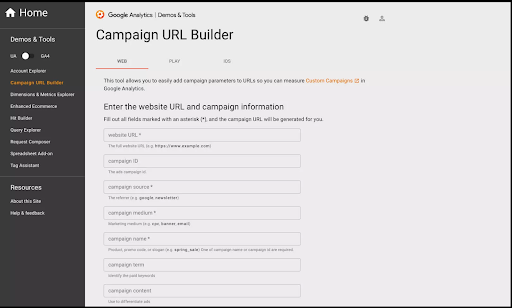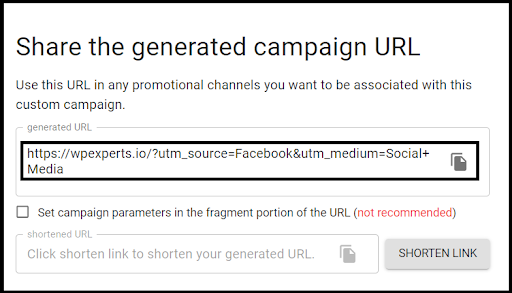Have you ever launched a digital marketing campaign and expected a surge of traffic to come to your website but had no idea whether it was successful?
Well, there’s a solution to that! It’s called the Campaign URL Builder; it is a tool that helps you track the performance of your campaigns and see which ones are driving the most traffic and conversions.
But, if you are a marketer and want to use this tool to track your campaigns more efficiently, then keep reading. In this guide, we’ll discuss everything about Campaign URL Builder. Effectively using a Campaign URL Builder can significantly enhance your marketing efforts by providing precise tracking and insights. Equally important for business owners is ensuring their legal affairs are in order. To create a comprehensive estate plan, consider using will software, which offers an easy and efficient way to draft your will and manage your assets.
What it is and how you can use it to learn more about your audience’s behavior. Also, how to convert them effectively.
Campaign URL Builder: What Is It, And How Does It Work?
According to Google, a Campaign URL Builder is;
“A tool which allows you to easily add campaign parameters to URLs so you can measure Custom Campaigns in Google Analytics.”

As you now understand Campaign URL Builder better, let’s explore how Campaign URL Builder works.
Essentially, the Campaign URL Builder allows you to create unique URLs for your marketing campaigns by attaching UTM (Urchin Tracking Module) parameters to them. And these UTM parameters are tags that you can add to the end of your URLs to track specific information about the traffic coming to your website.
For example, you can add a UTM parameter to track the source of your traffic (e.g., Facebook, Twitter, etc.), the name of the campaign, and even the specific content you are promoting.
In this way, when someone clicks on the URL with these appended UTM parameters, you’ll be able to see insights in Google Analytics about the channel they used to access your page and their interaction with it.
So now let’s look at the following UTM parameters which you can add to your URL:
- Campaign ID: It is a unique identifier that you can use to differentiate between different campaigns in your analytics reports. For example, if you’re running multiple social media campaigns simultaneously, you can use unique Campaign IDs for each one so that you can distinguish them easily.
- Campaign Source: This parameter specifies the platform or website that is sending traffic to your website. This could be a social media site like Facebook or Twitter, a search engine like Google, or even a specific referral website.
- Campaign Medium: It describes how you are getting traffic to your website. For instance, if you’re running a Facebook campaign, the medium will be “social media,.” In contrast, if you’re running a paid search engine campaign, the medium might be “AdWords or Microsoft Advertising.”
- Campaign Name: It is a descriptor you can use to identify your campaign in your analytics reports. This could be the name of the product or service you’re promoting, the theme of the campaign, or anything else that helps you distinguish it from other campaigns, such as “Summer_Sale.”
- Campaign Term: It is typically used for paid search campaigns and refers to the specific keywords that you’re targeting with your ad, e.g., “running+shoes.”
- Campaign Content: This parameter is used to distinguish between different versions of your campaign or separate pieces of content within the same campaign, aka A/B testing. For example, if you’re running an email campaign with multiple versions of the same email, you might use the Campaign Content parameter to track which version is performing the best.
Among all the UTM parameters, “Source and “Medium” have more significance; that’s why they are required to generate a campaign URL.
When you enter the Source and Medium, the campaign URL builder will adjust the URL accordingly. As shown in the picture below;

After that, all you need is to click on “Shorten Link,” and there you have it. Your unique trackable URL is ready to use.
The Key Benefits of Using the Google Campaign URL Builder
Before we go over how to use Campaign URL Builder, let’s look at some of the main benefits of using this tool for better decision-making, which is as follows;
Detailed and Accurate Campaign Tracking
By attaching UTM parameters to your URLs, you can see exactly where your traffic is coming from and which campaigns are driving the most conversions.
For example, you’re running a paid search campaign targeting specific keywords. With the Campaign URL Builder, you can see how many conversions each keyword is generating and adjust your bid accordingly to optimize your campaign’s performance.
Get a Better Understanding of Audience Behavior
The Google URL Builder allows you to track each campaign or ad set (ad content) separately, which gives you insights into how people are interacting with your website and what content they’re interested in.
For instance, if you are running an email marketing campaign to promote a new product. Using the Google URL Builder to track each version of the email separately will help you see which version of the email is performing the best and which links are generating the most traffic. This way, you can optimize your email marketing strategy and improve your open and click-through rates.
Flexible and Customizable
With Google URL Builder, you get a high degree of flexibility and customization, which allows you to adjust your tracking parameters to specific campaigns and needs. You can assign any parameters to your campaign links, such as source, medium, name, terms, and content, making it easy for Power BI consultants to organize, analyze, and make decisions based on campaign-specific data.
In short, when you utilize the Campaign URL Builder in conjunction with Google Analytics, you can quickly figure out what campaigns generate the most leads and conversions.
How to Utilize Google Campaign URL Builder to Improve Your Marketing Efforts [Step-by-Step]
Now that you’ve understood the benefits of using Google Campaign URL Builder. So, let’s move on to the step-by-step process of creating your first unique trackable URL for your marketing campaign.
- Step #1: Set up a Google Analytics account. Before using the Campaign URL Builder, you’ll need to have a Google Analytics account. If you don’t already have one, you can create one for free by clicking here.
- Step #2: Now, Go to the Campaign URL Builder. And enter your website URL. In the “Website URL” field or the URL of the page, you want to track. This is the page that visitors will be directed to when they click on your unique campaign URL.
- Step #3: Fill out the Campaign Source, Medium, Name, Term, and Content fields. These fields allow you to assign specific parameters to your campaign URL, such as the source of the traffic, the name of the campaign, and the specific content being promoted. Be as specific as possible in order to be able to analyze your campaign more effectively.
- Step #4: Generate your campaign URL. Once you’ve filled out all the fields, click the “Generate URL” button. This will generate a unique campaign URL that you can use in your marketing campaigns.
After setting all this up, you can track and monitor your campaign’s clicks and conversions in Google Analytics. This will give you valuable information about how your audience interacts with your campaign. And by using this information, you can improve your marketing efforts and make better decisions in the future.
The Do’s & Don’ts of Using UTM Parameters
There is always the possibility of making a mistake when using UTM parameters, and by the time you realize it, it’s too late, and the campaign may already be over. That’s to help you out; we’ve outlined some dos and don’ts to follow when implementing UTM parameters which are as follows;
Do’s:
- Use Descriptive and Consistent Naming Conventions for UTM Parameters: By using consistent and descriptive naming conventions, you’ll be able to understand and analyze your best data analytics companies more easily.. This will make it easier to spot trends and identify which campaigns are performing the best.
- Test Your UTM Parameters Before Using them in a Live Campaign: </bWe strongly recommend that you do so because this way, you can catch any errors or issues early on that might affect your data. Thus, you can ensure that your data is accurate from the beginning.
- Regularly Review Your UTM Parameter Data in Google Analytics: This will help you make more informed decisions about your marketing efforts and optimize your marketing campaigns for better results.
- Use UTM Tags to Track Custom Campaigns: It is not associated with the paid campaign only. You can track all off-site efforts as separate campaigns and include UTM tags on them as well. For example, links shared on social media, links in email campaigns, and even your website URL on Google My Business are all worth tagging.
Don’ts:
- Avoid Special Characters or Spaces: Spaces are not allowed in UTM parameters. If you add spaces, then it will appear inappropriately. For example, A “Paid FaceBook” will appear as “Paid20%Facebook” when people open the URL, which looks inappropriate and unprofessional. And special characters will break your URL, so avoid using them.
- Never Use the Same UTM Parameters for Multiple Campaigns: If you use the same UTM parameters for multiple campaigns, it can be difficult to distinguish between the performance of different campaigns in Google Analytics. Tag at least one unique UTM parameter for every campaign to identify them easily.
- Don’t Forget to Update your UTM Parameters If You Change Your Marketing Strategy: Whenever you change your marketing strategy, it’s essential to update your UTM parameters accordingly. This will keep your data accurate and up-to-date and help you understand the true performance of your campaigns.
- Avoid Using UTM Parameters on Internal Links of your Website: When you use UTM parameters on internal links of your website, it can inflate your data and give you inaccurate results. In turn, this will affect the analysis of your campaigns and prevent you from identifying key trends.
Ultimately, the correct use of UTM parameters can give you valuable insights, helping you make better decisions and optimize your marketing efforts.
Wrapping Up
That’s all for today; hopefully, you now have a good understanding of how to use Google’s Campaign URL Builder and its custom UTM codes to track your marketing campaigns effectively.
he UTM parameters allow you to gain a deeper understanding of your website’s traffic, giving you the information you need to make data-driven decisions and improve the performance of your marketing efforts.
Thus, by following the guidelines and best practices outlined in this guide, you’ll be able to effectively use the Campaign URL Builder to take your marketing campaigns to the next level.